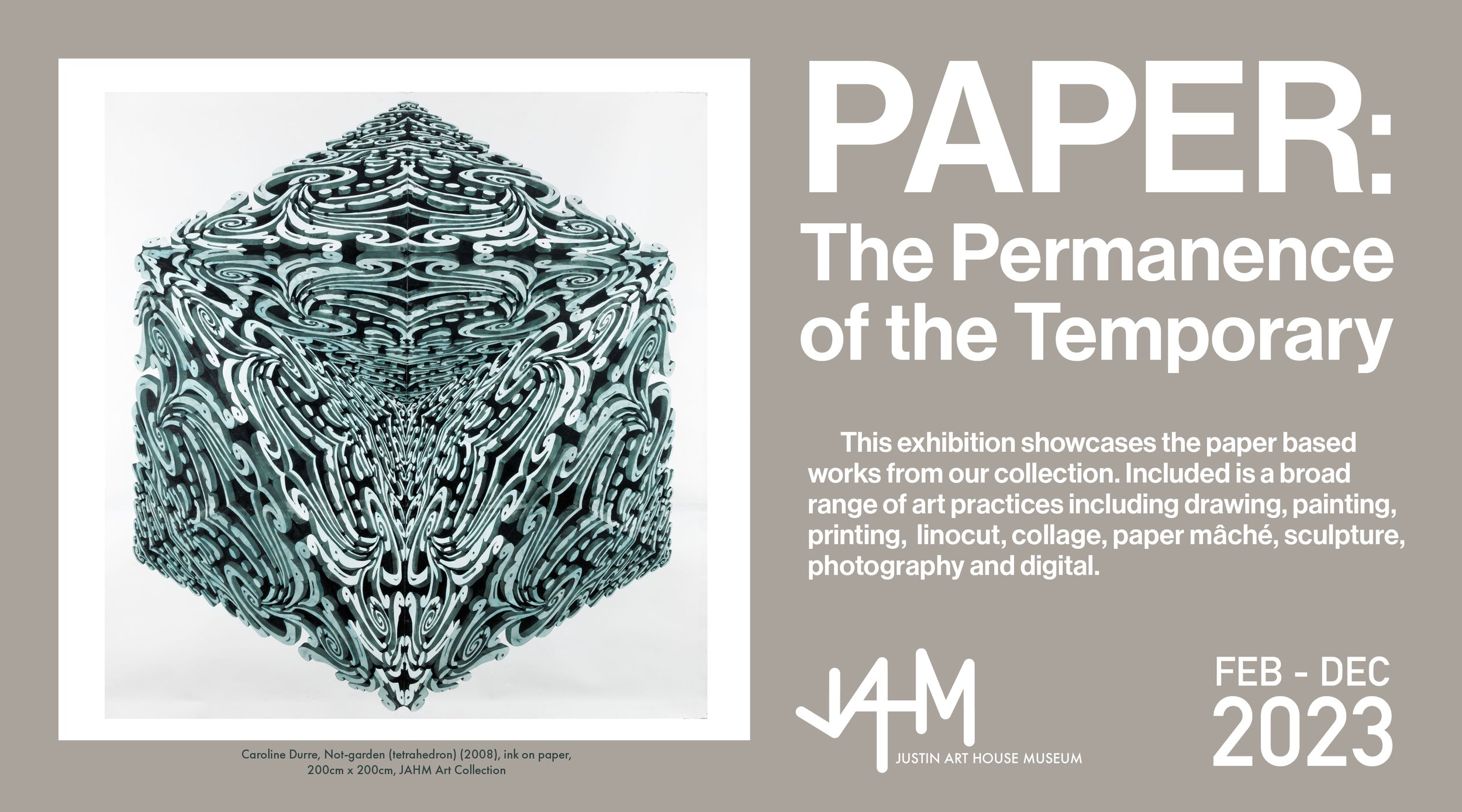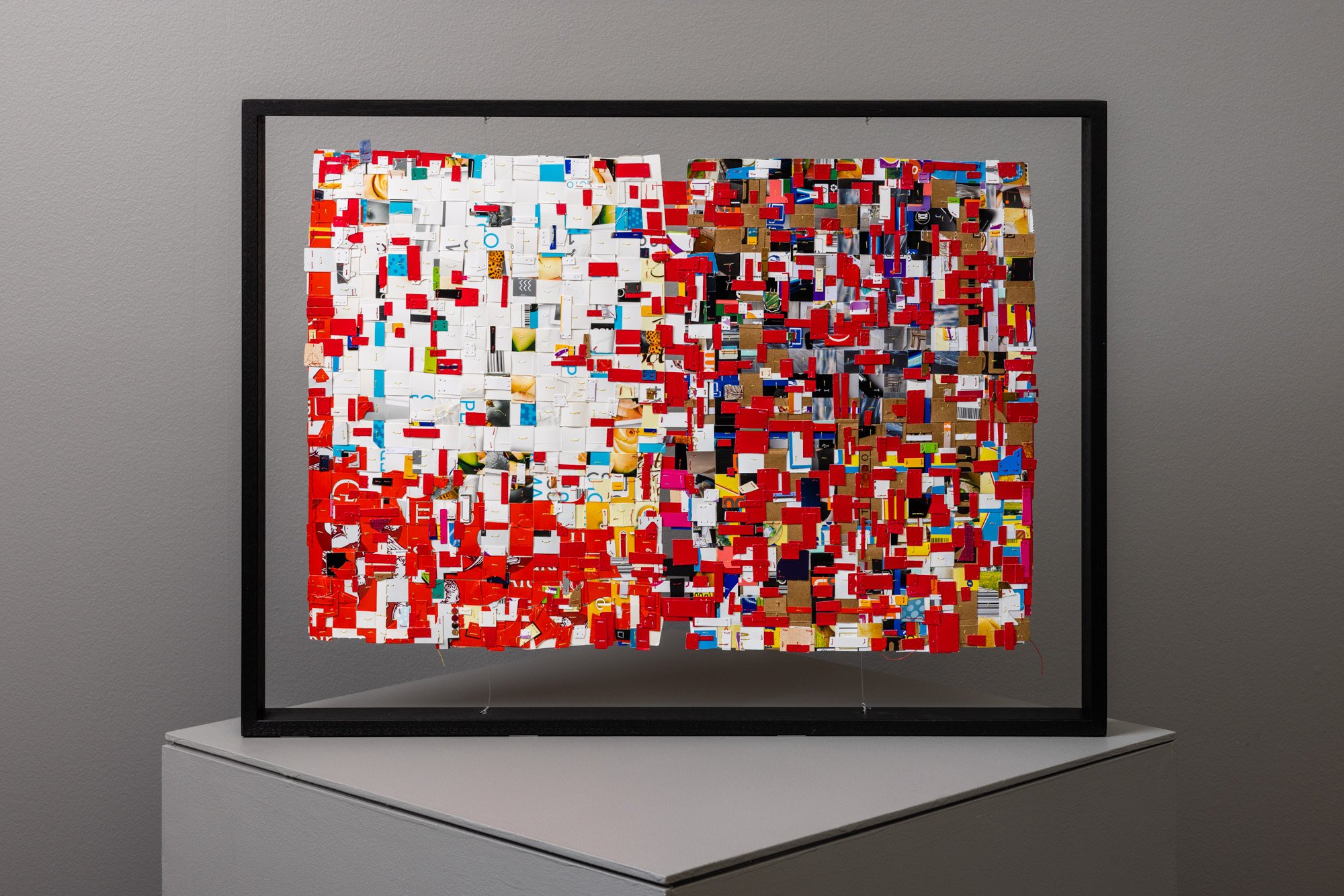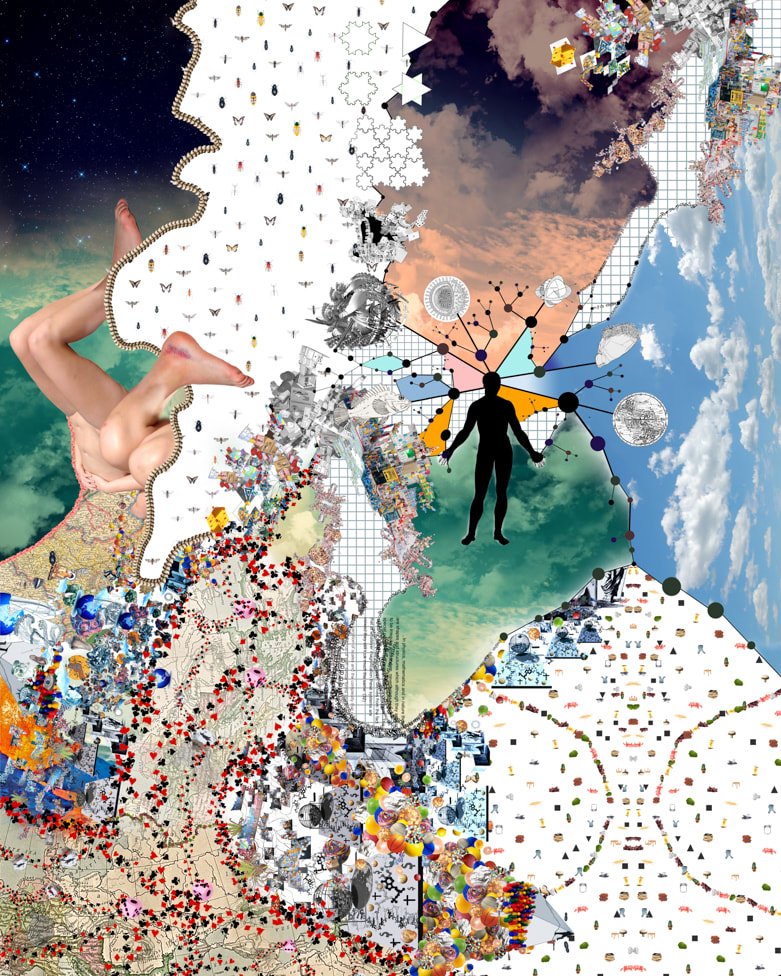2023 EXHIBITION

February 2023 - November 2023
JAHM in 2023 offers much to reflect upon with two concurrent exhibitions. PAPER: The Permanence of the Temporary is showing in the main gallery. With over 60 paper-based works from the JAHM collection, the exhibition examines the temporal and fragile nature of paper, and how this contrasts with the permanence associated with art. An exhibition of recent JAHM acquisitions, including challenging AI generated paintings, conceptual and media-based art, as well as dramatic works in abstraction offers much food for thought in the upstairs apartment. And of course, there is always food.
JAHM tours of PAPER: The Permanence of the Temporary are available to book now. A visit offers a rich exposure to the fascinating contemporary art on display and the stories and ideas behind their creation.
JAHM SESSIONS
SPECIAL EVENTS
EXHIBITION CATALOGUE
CURATORIAL ESSAY
Charles Justin AM, Justin Art House Museum
When I started my life in architecture, I was subsumed by paper. As a student it was drawings on paper, essays, exams, reports and finally a degree issued on paper. In my practice of architecture it continued, sketching on butter paper, drawings on tracing paper, printed plans on paper, cardboard models, specifications, correspondence, consultancy agreements, building contracts, all on paper. Even my registration as an architect was on a piece of paper.
The role of paper in this instance was as a vehicle for transmission - ideas, information, instructions, obligations, and responsibilities, with the objective of producing a building. Paper was a means to an end not an end in itself. Once its role had been fulfilled, all this paper could be discarded, albeit in some cases some of it was kept for legal reasons or as a record for posteriority.
Paper is ubiquitous in our lives. It has been calculated that there are twenty thousand ways that paper is used in our daily lives. Whether in letters, newspapers, magazines, books, manuals, invoices, receipts, bank statements, maps, brochures, notepads, exercise books, cartons, packaging… the list is endless. Interestingly, the roles the above items fulfill are not dissimilar to that in architecture, that of transmission and generally when done, the paper is discarded either to be trashed or recycled.
Why is this so? Essentially because paper is cheap, abundantly available, comes in a vast range of types, is versatile in its many uses, is light and portable and is recyclable. However, paper is also fragile, easily damaged, deteriorates in light and humidity and requires a lot of care and environmental controls to preserve long-term.
Art on the other hand is regarded as having high cultural and often financial value. It has the character of longevity and even permanence. Whether in a home where it is held long term, even sometimes passed from one generation to the next, or in a museum where it is regarded as an object of material culture to be held as permanently as possible.
The title of this exhibition, PAPER: The Permanence of the Temporary, highlights the contrast between the temporary character of paper as described above, against the expectation of permanence associated with art. The exhibition explores why artists choose to work with paper, even with all the challenges in preserving its longevity.
This exhibition has nearly 60 works from our collection on display, which presents a comprehensive representation of not only the different forms of paper used by artists, but also the wide variety of art practices utilising paper.
In this essay, we speculate on the reasons that artists are attracted to and use paper, illustrated by the works in our exhibition.
Materiality
Paper comes in a huge range of types. The material it’s made from, its density, texture, thickness, absorption quality, colour, coatings, transparency, and construction. There are four categories of paper - tissue, writing, newspaper, and cardboard, however within each category there are a large number of varieties. This materiality is celebrated by artists where the paper is exposed and expressed as part of the artwork. Even in the framing, it is common for works to be floated within the frame to express the full extent of the paper, its surface and edges as can be seen in many of the works in the exhibition.
Art Practice
There is a broad spectrum of art practices applied to paper, each suited to a particular type of paper. Whether it’s drawing, painting, printing, sculpture, photography, digital or artist books, there is an optimum match between the medium and the paper.
Drawing
Artists do a lot of drawing, often as preparatory studies for paintings, sculptures and other practices. However, in some cases the drawings are intended as the final work such as Justin Andrews, Metal Array (2014) and Ry Haskings, 1-6 (2011) graphite works and Hamish Carr’s Untitled 6 and Untitled 8 (2010) in pencil and ink. In each of these works, the paper is expressed as a component of the composition.
Painting
Paintings are usually executed on canvas, linen, board or other long-lasting material. Sydney Ball’s Untitled (1986), Shirui Li’s 177 (2011), Magda Cebokli’s Icône #10 (2017) in acrylic and Charles O’Loughlin’s Statiscical Predictor for February (2012) in gouache on paper, demonstrate that artists also paint on paper. Whether intended as final works or studies for paintings on canvas, or part of a series of experimentations, these works nonetheless form part of our collection and this exhibition as works in their own right.
Ink and Watercolour
Although a form of painting, ink and watercolour are predominantly applied on a particular type of paper, referred to generically as watercolour paper, which has certain absorptive qualities that enhances the spread and intensity of the ink or watercolour paint. This paper comes in several types and grades which respond to the ink and watercolour paint in different ways. This is demonstrated by several works in the exhibition including Caroline Durré, Not Garden (Tetrahedron) (2008), Paul Uhlmann, Five Wounds to the Body (1992), Simon Finn, Passage Ascent One (2018), Vanessa Russ, Unseasonal Waterhole with Lilies 6 (2022) and Elisabeth Bodey, Descending 2.0 (2011).
Printing
Printing allows for the production of multiple copies, generally in limited editions, which allows the artists to broaden their exposure and present works at a lower cost than unique works. There are a broad range of printing methods which are represented in this exhibition:
Silk screens – Lars Breuer, Motorradlarm (noise of motor) (2005), Colin Jordan, Blue Red Stack (1972), Peter Hill, Plato’s Cave (1989)
Lino-cut – Melissa Smith, Holding My Breath (2010)
Monotypes – Wayne Viney, Above and Below (2004), Sunlight and Shadows (2004), Radiance III (2010), each of which are unique prints.
Lithographs – Although there are no lithographs in this exhibition, Tim Maguire’s Study for a Lithograph (1987) counterintuitively is a painting on canvas whose primary purpose is to produce a work on paper.
Photography
Photography has been described as painting with light which generally are printed on paper. Photographic paper comes in a wide variety of types, which artists have adapted in creative ways to augment the image. Janina Green, Red Vase (1990) is a black and white photograph where the red colour has been applied with red dye. Like in printing, this work, as with most art photography, was presented as a limited-edition print.
Photography as an artistic medium, looks to create the image through the technology of photography, either by its composition, its construction, manipulation or augmentation. David Thomas, Brandenburg Gate (2006) and Gabriela Albergaria, Garden of the Old Palace of Pombal (2013) illustrate how photographs have been augmented by painting and drawing.
Digital
Digitally generated art, which can be experienced on digital devices, is often printed on paper, not unlike photography, illustrated by Tracy Coutts, Untitled (2016), Annika of tbC, The Art of Conversation (2017), Gordon Monro, Tree Circle (2011), Greg Neville, GoooOg (2012), and Louisa Bufardeci, Ground Plan (2003).
Sculpture
Paper is often regarded as a material that artists draw, paint or print on. However as can be seen in the exhibition, it is also a construction material that can create two and three-dimensional objects.
The collage works of Julia Powles, My Heart is a Machine (2012), Jocelyn Tribe, Positive Negative (2012) with their cutting and pasting, contrast with Jacob Leary, The Sorting Process (2012) where the cutting and pasting was done digitally. Eva Stimson Clark, Once Upon a Time, There Were Two Philophobes Who Met in a Grocery Store (2022) stiches her cut-outs together, where the stitching is exposed as a work of art in itself. Kirstin Berg, Monument II (2016) takes collage to another dimension. Andrew Christofides’ Relief Construction (358) (1991) meticulously constructed geometric work and Dinh Cong Dat’s Positive and Negative Mask (2004) paper mâché Buddha masks highlight the potential of wall mounted relief sculptures. This leads to the free-standing three-dimensional works by Nick Selenitsch, Structural Goal (2011) and Nick Mangan OBTX Cylinder Mold I. Finally, Rebecca Baumann, Automated Colour Field Flip Clock (2017) goes a step further with her mechanised kinetic work utilising laser cut coloured paper.
Books
Books play a big role in the artworld, catalogues, monographs, theoretical dissertations, sketchbooks, diaries to name a few. But they also act as a vehicle for artistic expression. Elizabeth Banfield, The Abeyant Memory and its Promise (2011) and Liz Jeneid, Facebook and Twitter (2018) utilize the book form to create paper sculptures. Marco Fusinato, Mass Black Implosion (2013) is a signed limited-edition catalogue of works in the exhibition of the same title, which pushes the boundary between the art and its catalogue.
The creativity and diversity expressed in this exhibition highlights why artists are attracted to paper as a medium for artistic expression. There are just some things that can be done better with paper that cannot be matched by other materials. Paper’s materiality, availability, affordability, versatility and utility, demonstrates its attraction to artists and art lovers and is richly demonstrated in this exhibition.
STAY CONNECTED
Be sure to keep up with all JAHM updates and Australian exhibition highlights by connecting to our socials. And if you haven’t already, subscribe to our mailing list to receive newsletters with all details of upcoming programs and tours at JAHM.














































































